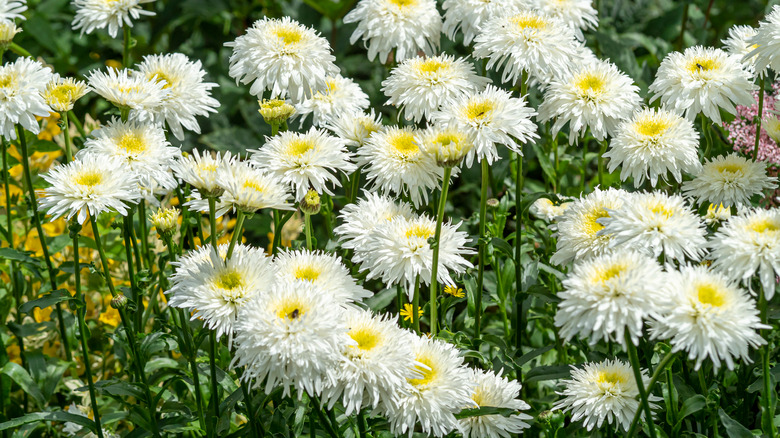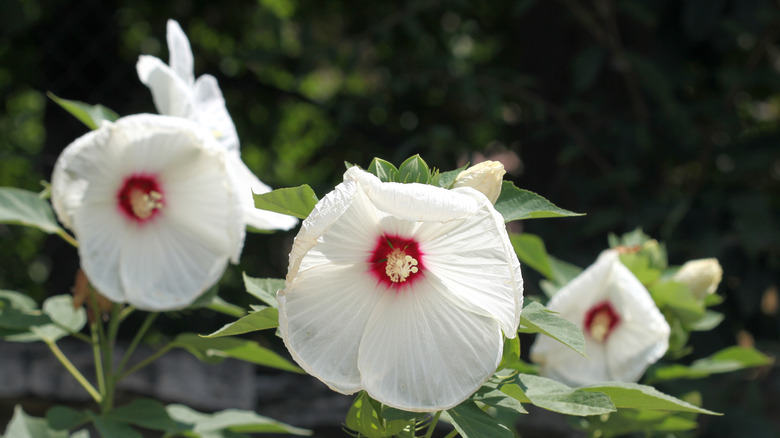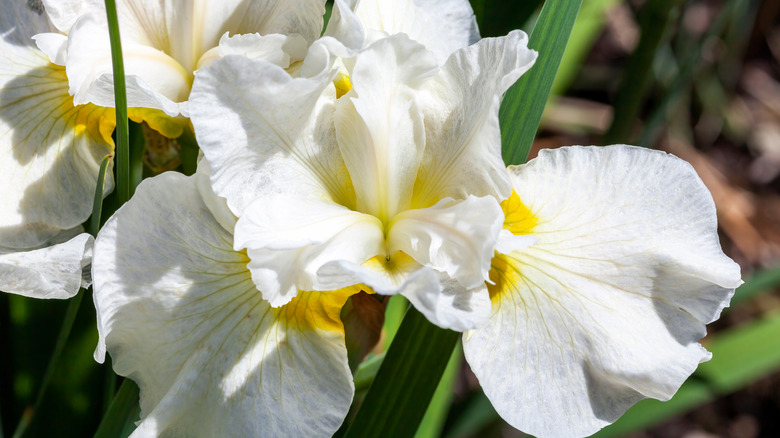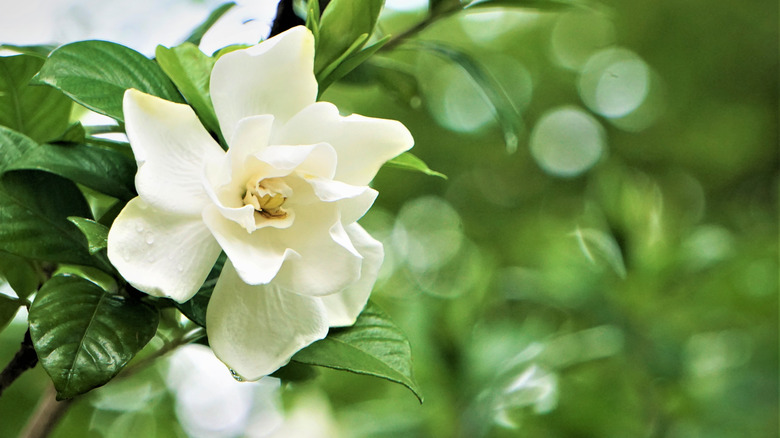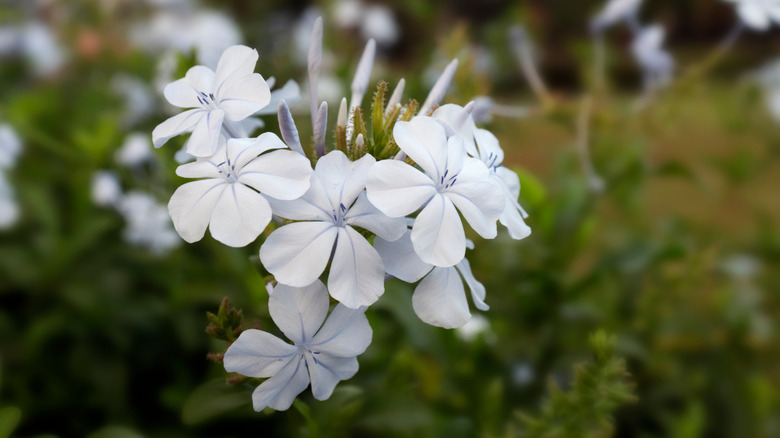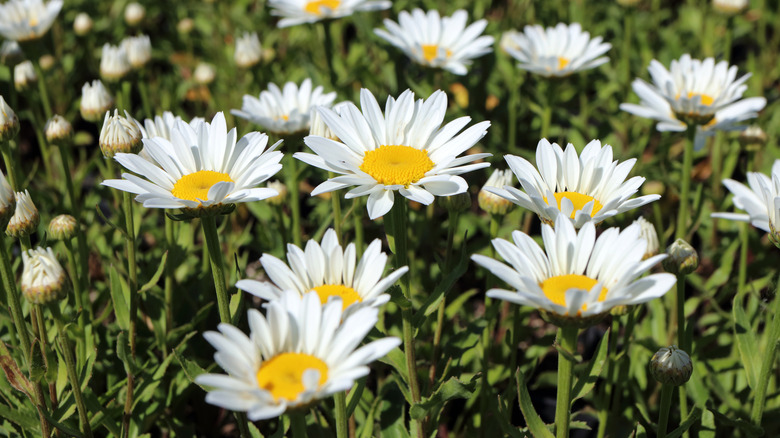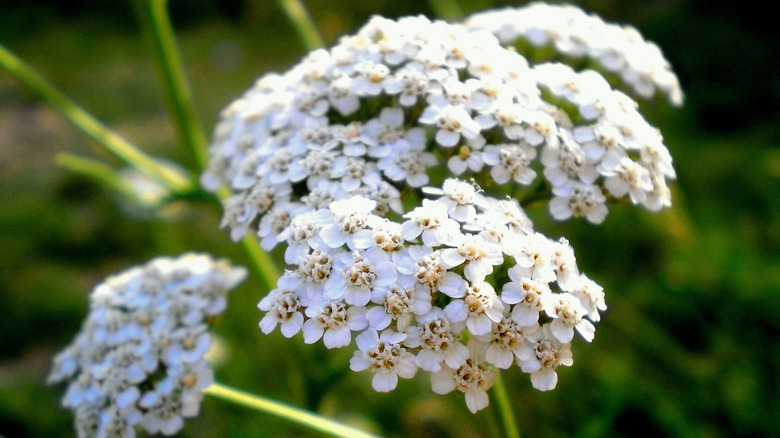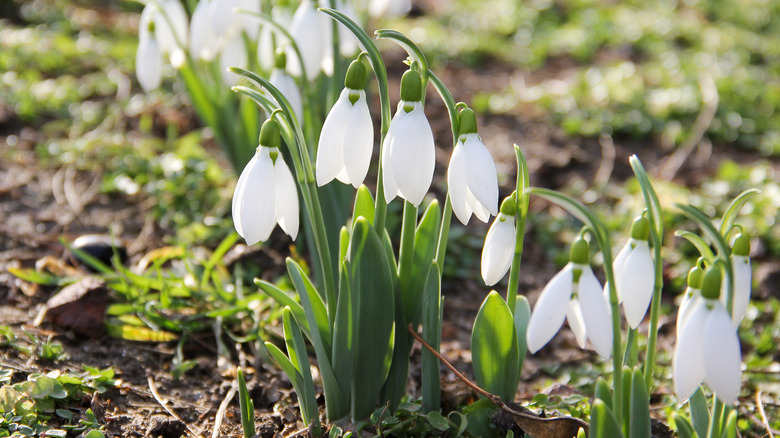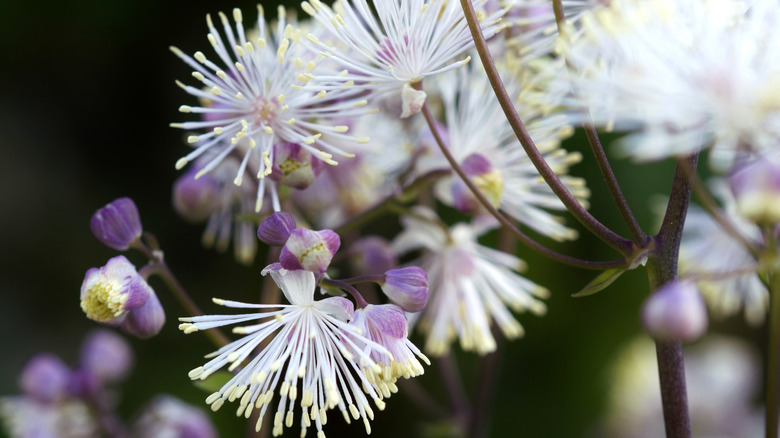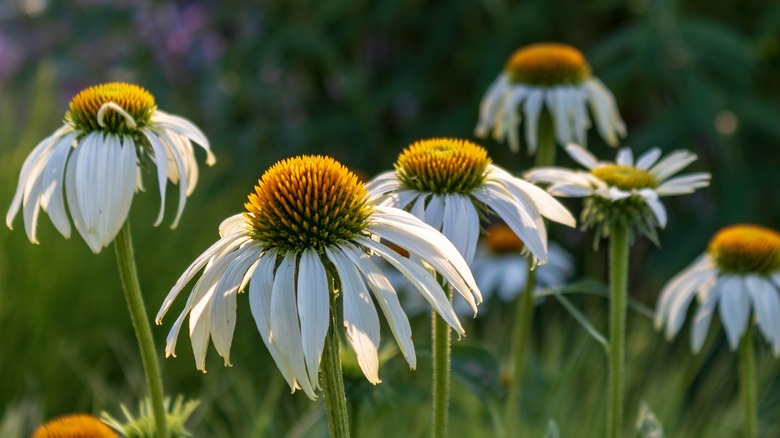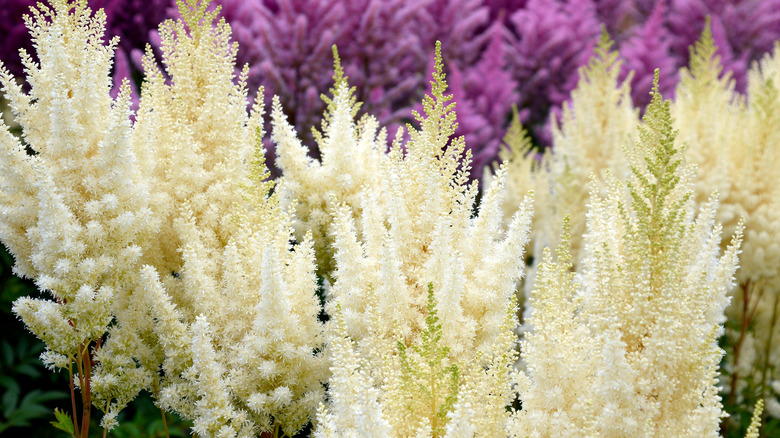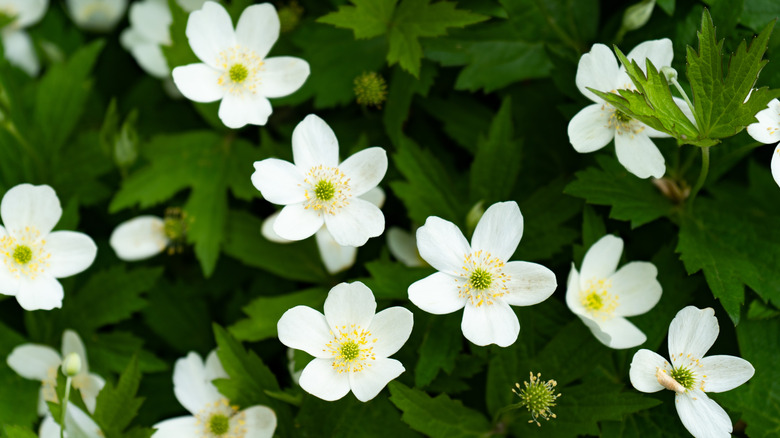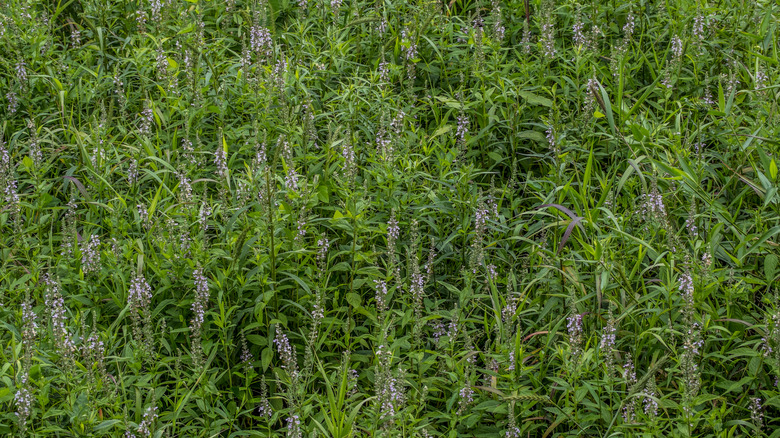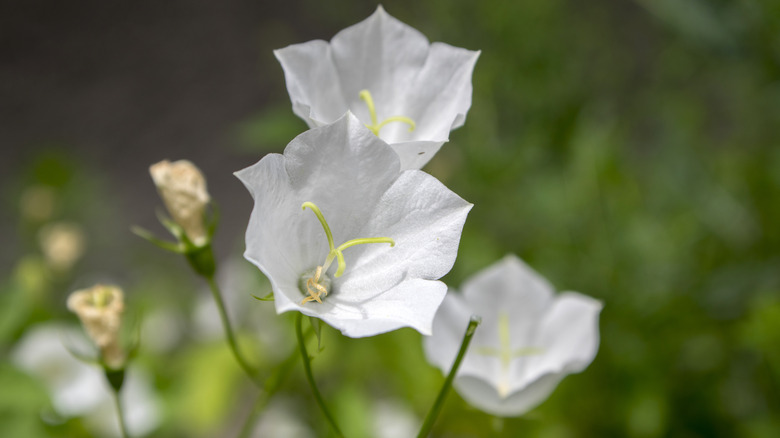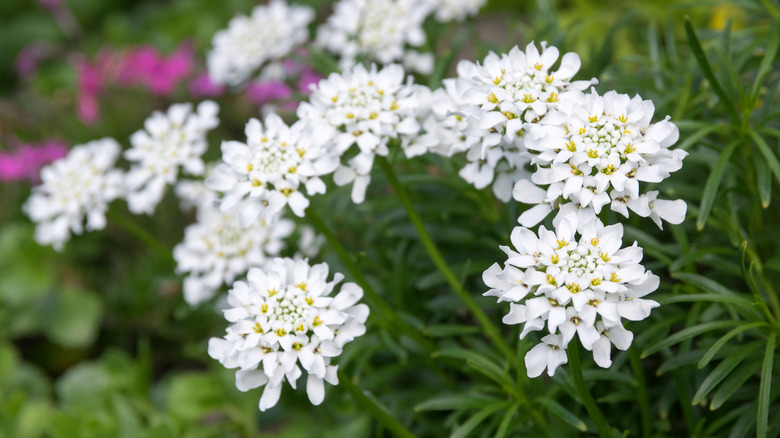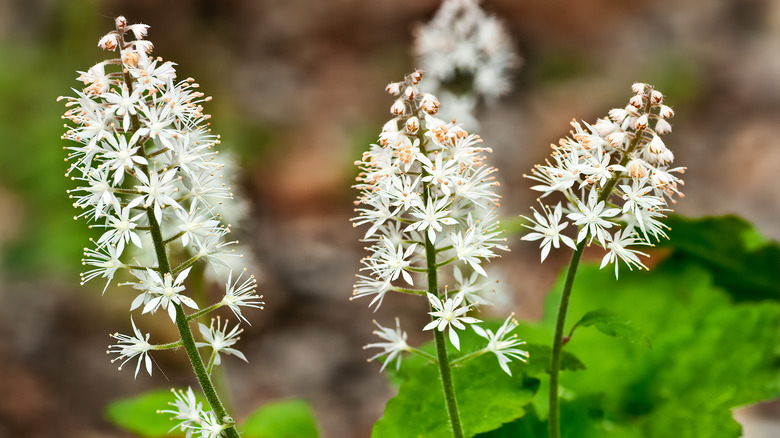15 Perennials That Bloom With Stunning White Flowers
White-blooming plants are often overlooked because people think their options will be limited and uninspired. Instead, gardeners looking for bright and bold flowers tend to go for shades of red, yellow, purple, and blue. While a colorful garden can be amazing, it can also become too overwhelming to look at. Adding white flowers to your design will enhance the colors of your favorite perennial plants and brighten your garden throughout the day and night.
White flowers have been said to add a pure and calming vibe that brings more tranquility to your lawn and garden beds, explains City Flowers. This bloom color is easily found in stores and online, and there are literally hundreds of species from which to choose.
From large hibiscus flowers to dainty, fragrant cape jasmine gardenias, your options are seemingly limitless when you decide to add white blossoms to your perennial garden. When you're ready to start planting, take a look at these white flowers, all of which we think you'll love when you introduce them to your collection.
1. Swamp rose mallow
Swamp rose mallow (Hibiscus moscheutos) is a species of hibiscus that grows in ditches, marshes, wet prairies, and very shallow ponds or rivers, explains New Moon Nursery. A tall-growing wildflower, the swamp rose mallow is known for its 4- to 12-inch white flowers, which may occasionally also be rose, yellow, or pink.
Bloom Season: Summer
USDA Growing Zone: 5 to 8
Growing Conditions: Full sun
Soil Type: Rich and wet
Size: 4 to 7 feet tall and 3 to 4 feet wide
2. Siberian iris
Siberian irises (Iris sibirica 'Silver Queen') are adaptive plants that can grow well in a few different settings including rain gardens, border gardens, or around ponds, according to Monrovia. The blooms of these plants, which appear in the spring, are highly attractive, and, in addition to white, they can bloom in true blue.
Bloom Season: Spring and summer
USDA Growing Zone: 4 to 9
Growing Conditions: Full sun
Soil Type: Rich and well-draining
Size: Up to 2 feet tall
3. Cape jasmine gardenia
Cape jasmine gardenia (Gardenia jasminoides) is well-known for its stark white flowers that may remind you of freshly washed linen or newly fallen snow. These blooms are lightly fragrant, though they do not smell the same as common jasmine. National Parks notes that this plant should be grown in partial shade in well-draining and fertile soil.
Bloom Season: Spring to summer
USDA Growing Zone: 6 to 10
Growing Conditions: Full sun
Soil Type: Fertile and well-draining
Size: 2 to 7 feet tall
4. Hybrid phlox
Hybrid phlox (Phlox "Fashionably Early Crystal') features clusters of bright white flowers that bloom in the summer. Per Walters Gardens, this plant is larger than most phlox species, and it produces its flowers earlier too. When planting this hybrid cultivar, be sure to provide it with some shade and regular watering.
Bloom Season: Summer
USDA Growing Zone: 4 to 8
Growing Conditions: Full sun to partial shade
Soil Type: Fertile and well-draining
Size: 26 to 32 inches tall and wide
5. Shasta daisy
Shasta daisies (Leucanthemum x Superbum) are known for their low-maintenance qualities and white flowers that look almost identical to common daisies. These flowers prefer direct sunlight and relatively dry soil, notes North Carolina State Extension. With little effort, you can grow white Shasta daisies in almost any garden plot.
Bloom Season: Spring and summer
USDA Growing Zone: 4 to 9
Growing Conditions: Full sun
Soil Type: Well-draining
Size: 1 to 4 feet tall and 1 to 2 feet wide
6. White yarrow
White yarrow (Achillea millefolium), which is often planted for its ability to attract pollinators and other beneficial insects, is native to many parts of the United States. This makes it a wonderful addition to any outdoor garden that can support the plant's needs, as mentioned by Clemson Cooperative Extension.
Bloom Season: Mid-spring to summer
USDA Growing Zone: 3 to 9
Growing Conditions: Full sun to partial shade
Soil Type: Nutrient-poor and dry
Size: 3 feet tall and 1 foot wide
7. Snowdrop
Snowdrops (Galanthus spp.) are an elegant and early-blooming perennial native to Europe and Asia. They can be identified by their white flowers that hang downwards with six petals, as described by the University of Wisconsin-Madison. Snowdrop foliage is just as beautiful with its upright leaves and stems, which are usually dark green.
Bloom Season: Winter and spring
USDA Growing Zone: 5 to 8
Growing Conditions: Full sun
Soil Type: Rich and well-draining
Size: Up to 10 inches tall
8. Meadow rue
Meadow rue (Thalictrum aquilegifolium) or columbine meadow rue is a member of the Ranunculaceae family along with buttercups, hellebore, and clematis. The plant boasts fern-like leaves and a tall growth habit that gives it ornamental purpose even when it isn't in bloom. Its white flowers appear in the spring, and they can also be found in pink or purple, as noted by Cornell University.
Bloom Season: Spring and summer
USDA Growing Zone: 5 to 8
Growing Conditions: Full sun to partial shade
Soil Type: Fertile and well-draining
Size: 2 to 3 feet tall and 1 to 2 feet wide
9. White coneflower
White coneflowers (Echinacea purpurea 'White Swan') are grown in perennial gardens all over the United States. These flowers are quite cold-hardy, and their 2- to 4-inch wide flowers look great no matter where you plant them. As suggested by Clemson Cooperative Extension, coneflowers should be planted in direct sunlight where they can enjoy warm temperatures during the summer.
Bloom Season: Summer to fall
USDA Growing Zone: 3 to 9
Growing Conditions: Full sun to partial shade
Soil Type: Moist and well-draining
Size: 4 feet tall and 2 feet wide
10. False goat's beard
False goat's beard (Astilbe spp.) is a slow-growing perennial named for its resemblance to common goat's beard. This flower is usually chosen for the garden as its flowers may bloom in a variety of colors from summer until the first frost. They also grow quite tall, which adds great vertical interest to any yard, says Longfield Gardens.
Bloom Season: Summer
USDA Growing Zone: 3 to 8
Growing Conditions: Partial shade
Soil Type: Evenly moist and well-draining
Size: 10 inches to 4 feet tall
11. Meadow anemone
Meadow anemone (Anemone canadensis) is a ground cover plant that produces adorable, 5-petaled flowers atop stems covered in serrated, dark green foliage. This flower is known to spread quickly which makes it a great option as an alternative to grass. But, you should be careful planting it among weaker plants that it may choke out with its underground rhizomes, warns Prairie Nursery.
Bloom Season: Spring and summer
USDA Growing Zone: 3 to 6
Growing Conditions: Full sun to partial shade
Soil Type: Evenly moist and well-draining
Size: 1 to 2 feet tall
12. Perennial salvia
Perennial salvia (Salvia nemorosa 'White Profusion') looks almost identical to the purple-blooming sage you're likely already familiar with. The only difference is this cultivar produces dainty white flowers that give off an earthy aroma. Missouri Botanical Garden points out that the 'White Profusion' cultivar is attractive to pollinators such as bees and butterflies, so it can be a nice, lasting addition to a pollinator garden if you so choose.
Bloom Season: Summer to fall
USDA Growing Zone: 4 to 8
Growing Conditions: Full sun
Soil Type: Well-draining
Size: 18 to 21 inches tall and wide
13. White clips bellflower
Carpathian bellflowers (Campanula carpatica 'White Clips') come from the Campanula genus that is known for hosting more than 300 distinct species, as per the University of Wisconsin-Madison. The Carpatica flowering species is typically found with blooms appearing blue and purple, but the 'White Clips' cultivar stands out as a bright option for border gardens, rock gardens, or when used as ground cover.
Bloom Season: Summer
USDA Growing Zone: 3 to 11
Growing Conditions: Full sun to partial shade
Soil Type: Fertile and well-draining
Size: 6 to 8 inches tall and 12 inches wide
14. Evergreen candytuft
Evergreen candytuft (Iberis sempervirens) is a spring-blooming flower that produces clusters of dainty white blossoms. A low-growing plant, candytuft is typically planted at the front of border gardens or in between stones in rock gardens, as per Clemson Cooperative Extension. Nearly all candytufts bloom with white flowers, however, their blossom size, bloom season, and stem length may vary depending on the cultivar.
Bloom Season: Early spring
USDA Growing Zone: 3 to 9
Growing Conditions: Full sun
Soil Type: Well-draining, rich, and organic
Size: 6 inches tall and 3 feet wide
15. Foam flower
Foam flowers (Tiarella cordifolia) are a species of herbaceous perennials that can be identified by their sometimes variegated, heart-shaped leaves, and their spikes of white flowers that have a foam-like texture, hence their common name. Missouri Botanical Garden describes this plant as a low-maintenance, semi-evergreen, native flower that looks best in shady rock gardens, wild gardens, border gardens, and woodland gardens.
Bloom Season: Spring
USDA Growing Zone: 4 to 9
Growing Conditions: Partial to full shade
Soil Type: Well-draining
Size: 9 to 12 inches tall and 12 to 24 inches wide
